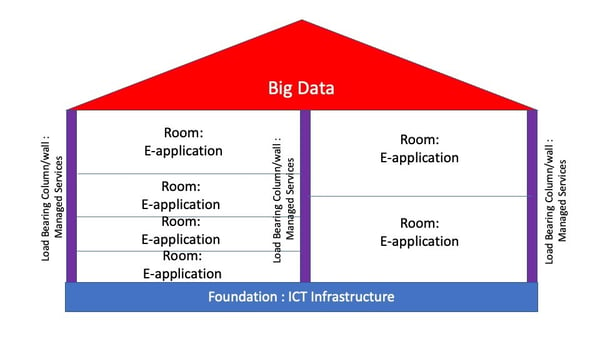
Would you build a house without using an architect Installing solid foundations and supporting load-bearing infrastructure? No, of course not! So why would we not apply the same principles to digital transformation?
According to McKinsey “Research shows that 70 percent of complex, large-scale change programs don’t reach their stated goals.” There are a variety of reasons why failure rates are so high, from a lack of clarity on the goals to be achieved, implementing ICT solutions that do not match business objectives to underestimating the sustainability costs of complex projects.
“Digital Transformation” is the buzz phrase of the moment. Across the Caribbean, we read and hear governments speaking of implementing a “digital transformation” program, for example, the Caribbean Digital Transformation Project (CARDTP), the digital transformation of Barbados Public Sector, Jamaica's drive for digital society
There are a wide variety of views of what “digital transformation” entails as expressed by the Gartner Group, “digital transformation can refer to anything from IT modernization (for example, cloud computing), to digital optimization, to the invention of new digital business models. The term is widely used in public-sector organizations to refer to modest initiatives such as putting services online or legacy modernization. Thus, the term is more like “digitization” than “digital business transformation.”
While a discussion on the meaning and consequences of choosing a particular view and approach to “digital transformation” is beyond the scope of this article, the common element surely must be to ensure the sustainability of any digital transformation program. After all, there is little use in spending millions of dollars or Euros on complex ICT projects if a plan for ongoing sustainability is not included from the outset. While there is little empirical evidence, anecdotally in the Caribbean there are examples where governments invested significant capital expenditure in ICT projects, but ongoing costs for maintaining, upgrading or replacing components over time had not been factored into the project and consequently not budgeted. This has led to periodic unforeseen capital cost spikes. Where budgets were not available, the sustainability of the project suffered.
Just as in building a house, sustainability and successful digital transformation is based on three fundamental elements, good architecture, solid foundation, and a consistent fit-for-purpose supporting infrastructure.
A house not built to a correct architectural design, without a solid foundation and without the correct load bearing support columns in place is certain to collapse.

Just as one should use qualified architects when designing and building a house, this should also be the case when implementing organizational or national digital transformation programs. According to the International Telecommunications Union (ITU) for successful implementation of a digital transformation program:
“a central building block is the digital enterprise architecture, which is the whole-of-government approach to support government ecosystems by transcending boundaries to deliver services in a coordinated, efficient and equitable manner. It is the critical component that translates transformation needs into specific functional and technical requirements that can lead to the deployment of transformation digital services.”
Having the correct flexible and adaptive architecture, based on international standards, is critical to the sustainable and successful implementation of a digital transformation program. If the effort is not put into the design phase (not just technical but also business function adaptation) of the transformation program the outcome will not provide the expected efficiencies or return-on-investment (ROI).
The International Standards Organization defines “Architecture” as follows “architecture: conceptualization of the form, function, and fitness-for-purpose of an enterprise (3.4) in its environment (3.9), as embodied in the elements of the enterprise, the relationships between those elements, the relationship of the enterprise to its environment and the principles guiding the design and evolution of the enterprise”

The key phrase here in this definition is “fitness-for-purpose”. Without undertaking a detailed enterprise architectural design program there is a very high probability that the outcome of the digital transformation program will not meet the expected results and the implemented environment may end up not being “fit for purpose”
Foundation
Drawing on the analogy of building a house, we can liken ICT infrastructure to the foundation of a house. The core infrastructure, which includes networks, data centres, hardware and security systems, etc., is fundamental to successful digital transformation. This is recognized in a report published by the Organization for Economic Cooperation and Development (OECD) which states:
“It is essential that G20 economies continually invest in the development of digital infrastructures to meet existing and future demand. They provide the foundation for many new services, applications, and business models. They are also crucial in underpinning and enabling the digital innovations that are transforming production, including in the context of Industrie 4.0.”
If there is a crack in this foundation the whole digital transformation structure is at risk of collapse. It is critical that the correct infrastructure is in place to support the goals of a digital transformation program. It is also critical that international standards such as ITIL and ISO are implemented in constructing the foundation. Without rigorous attention to standards, the possibility of cracks appearing in the digital transformation foundation will increase significantly leading to service outages and service disruption, and ultimately failure.
Supporting infrastructure

These are the critical support services such as cloud infrastructure management, cybersecurity, activity monitoring, and interventions, backup management, disaster recovery, etc. They are the back-office services that do the heavy lifting to support the innovative front-of-house applications. As digital transformation programs are increasingly complex and depend on high-availability environments, ensuring that the supporting environment is operational to at least a three 9s level (99.9% uptime) is critical. If digital transformation is successful the operational environment will be 24/7 365 days. It will not be possible to provide a supportive environment that is less than a 24/7 service. Typically many public sector ICT departments in the Caribbean do not provide such support. Equally having all expertise in-house will not be practicable both in terms of cost and availability of expertise. This is particularly so in small countries where there may be challenges with government budgets and skillset availability.
In such situations manages service providers (MSPs) can play an important role to assist governments to ensure that the critical back-office services are managed to very high international standards via service level agreements (SLAs). The core function of MSPs is to provide supporting infrastructure services. An MSP will typically have all the relevant expertise available.
To see how Cloud Carib can assist governments to achieve digital transformation success visit our website to see the range of services we provide and our experienced delivery team.